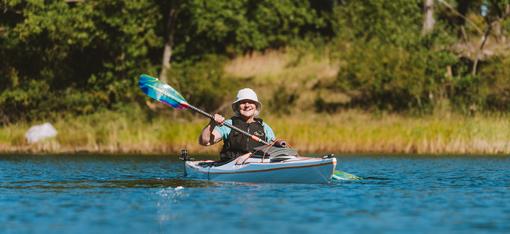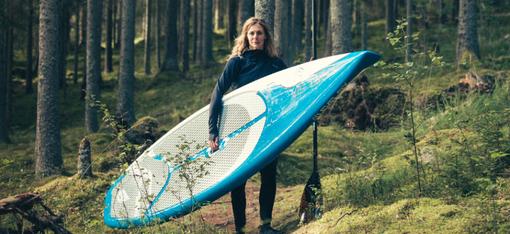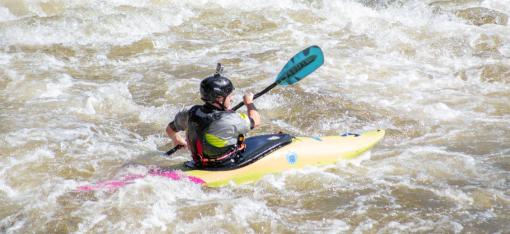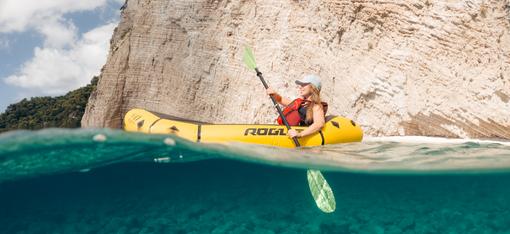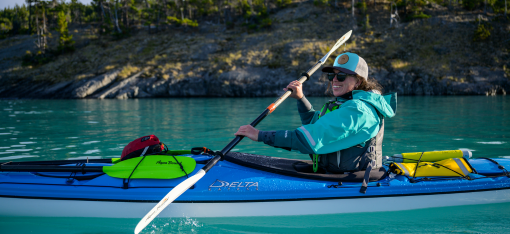Do You Need a Wetsuit or Drysuit for Paddling?
5-minute read
When you paddle on cold water or in cold weather, a wetsuit or drysuit a key safety gear in case you capsize. But which is best for you? Let’s look at the differences…

Do you kayak, packraft or paddleboard in cold weather? Or on big or swift cold water? If you do, then a wetsuit or drysuit is a wise investment for your safety.
Hypothermia is a real danger if you capsize in cold water and can’t get to shore or re-enter your boat quickly. This is true even when wearing a PFD, although that will help keep your core warm for a little while.
Wetsuits and drysuits are made of different materials and perform different functions. There’s also a big price gap between them. While wetsuits start at under $100 for the Farmer John style, drysuits start at several hundred dollars and easily top $1,000.
Our friends at Headwaters Kayak produced a video that explains the difference between these two:
Is a Wetsuit Your Best Option?
Many paddlers can’t afford to spend hundreds of dollars on a drysuit, so a wetsuit is their only real option for cold-weather SUPing, kayaking or packrafting.
Wetsuits are made of neoprene. If you end up in the water, you will get wet inside the wetsuit, but it offers a layer of insulation that warms the water next to your skin with your body heat.
They work well for northerners in the early spring and fall, and for southerners during the winter as they also help keep you warm when you're on your boat in cold air temps. So you won’t have to layer up as much if you wear a wetsuit under your outer layers.

Wearing wetsuit variations on a 3-day summer kayaking trip on Lake Superior (photo courtesy of Emilie O’Connor)
The reverse of that is one of the wetsuit's biggest disadvantages: If you’re on big cold water like Lake Superior or the North Atlantic on a hot summer day, you’ll get pretty gross and sweaty underneath your wetsuit (although you could always jump in to cool off for a bit, as long as you’re able to re-enter easily!).
A wetsuit is made to get wet. It’s really designed for surfing, diving and cold-water swimming when you’re in the water constantly. But it’s absolutely better than not having one if it means the difference between safety and hypothermia in case of a capsize.
Types of Wetsuits
Wetsuits come in varying degrees of thickness (measured in millimeters) and coverage.
A full wetsuit covers your core, legs and arms down to your ankles and wrists. This design will obviously provide the most protection from cold water temperatures.
A Farmer John (for men) or Farmer Jane (for women) design is sleeveless, which gives you more options for your top half. These models come with full leg coverage down to your ankles, or you can opt for the Shorty version, which comes just above your knees.
This design is great for recreational summer paddling on very cold water. You can combine the wetsuit with a neoprene top or jacket and even a dry top, which makes layering an option. Covering your core is the most important.
Add Neoprene Socks or Boots
If you want to keep your feet covered as well, consider also getting some wetsocks, wetshoes or neoprene boots. Here are a few examples of what’s available.
Is a Drysuit Your Best Option?
If paddling is a huge part of your life and you’re on the water often in cold weather or cold water, a drysuit is your best choice. It’s a big investment but will be worth it in the long run.
A drysuit is designed to be worn dry, but will keep you (mostly) dry in the event of a capsize. That means once you’re back in your boat, you’re not soaking wet inside. Drysuits also protect you from rain, sleet, snow and splash while you paddle.

Some paddling environments require drysuits year-round (photo courtesy of Stora Kornö Lokalavdelning)
There are a few major differences between a wetsuit and a drysuit:
- The clothing you wear under a drysuit is extremely important. A drysuit is just a shell. It doesn’t offer any insulation on its own, so you’ll need layers for warmth underneath in cold air temperatures.
- It’s lightweight and more comfortable than a wetsuit.
- A drysuit is much more expensive, although a good one should last you two to three decades.
- Drysuits include foot coverage.
One thing to keep in mind whether you choose a wetsuit or drysuit: Neither will keep you warm indefinitely. You’ll still want to get out of very cold water as soon as you can.
Wrapping It Up
You may be able to find a used wetsuit or drysuit. That’s a great option if you have the time to look around. It’s much easier on the budget and you may be able to find a gently-used one in your size.
To buy new, here are some brands we recommend: NRS and Kokatat are American brands. Level Six is based in Canada. UK-based brands are Typhoon and Palm Equipment. All sell worldwide.
What paddling questions can our Wisconsin-based Customer Service team help you with? Contact us at 715-755-3405 or sales@aquabound.com, or choose our online chat option.
More for you...

